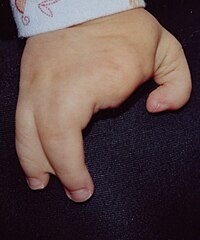
Photo from wikipedia
Limb deformity and shortening remains a common presenting complaint in paediatric orthopaedics. The ability to restore length, alignment with consistent bone formation allows standardised treatment in these difficult conditions. The… Click to show full abstract
Limb deformity and shortening remains a common presenting complaint in paediatric orthopaedics. The ability to restore length, alignment with consistent bone formation allows standardised treatment in these difficult conditions. The use of an external fixator produces a stable construct which allows manipulation of the bone segments, with a controlled rate and rhythm. Deformity analysis permits the surgeon to plan osteotomy levels and frame application to produce accurate correction. Complications, especially in congenital conditions remain an issue and modification of the treatment is required to try and reduce their incidence. New types of fixators, the latest being hexapod frames, have increased the versatility in deformity correction. The aim of this paper is to review the use of external fixators in elective paediatric orthopaedics and highlight the latest changes in technique and application for the limb reconstruction surgeon.
Journal Title: Injury
Year Published: 2019
Link to full text (if available)
Share on Social Media: Sign Up to like & get
recommendations!